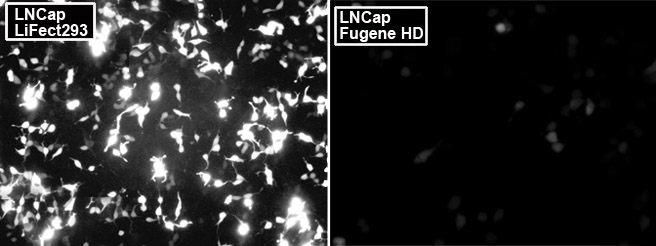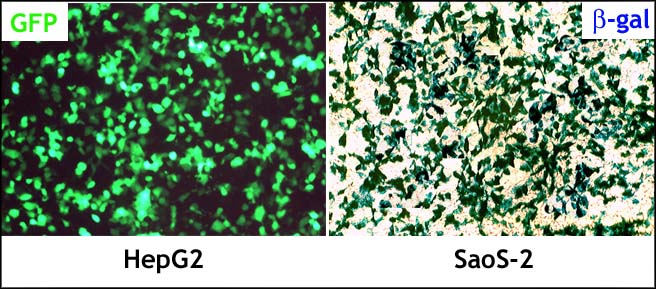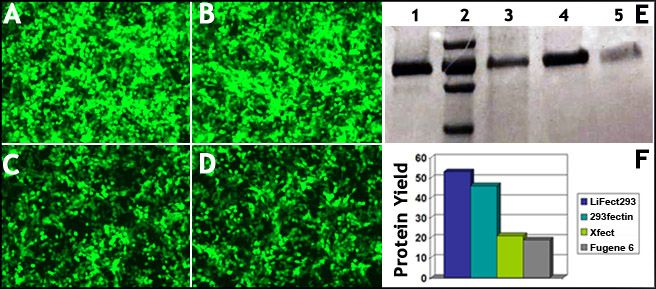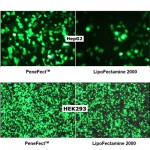By utilizing our innovative and proprietary lipid conjugation technology, LiFect293™ Transfection Reagent is specially designed and formulated by adding proprietary enhancers for transfecting HEK293 cells and other mammalian cells. As a 2nd generation liposome based DNA transfection reagent, the reagent offers extremely high transfection efficiencies for HEK293 related cells as well as many mammalian cells with less cytotoxicity. The reagent, upgraded from its previous version with refined chemistry, is 3~4 times more efficient in gene delivery. The reagent , 1.0 ml, is sufficient for ~666 transfections in 24 well plates or ~333 transfections in 6 well plates.
Key Features
• Exceptional high titers of virus production.
• Equally good for very long DNAs (up to 180 kb).
• Equally good for suspension 293 cells (e.g., 293F, 293H, etc.).
• High levels of recombinant protein production.
• Presence of serum and antibiotics enhances efficiency on 293 cells.
• Exceptional efficiency for both single DNA transfection and multi DNAs co-transfection.
Applications
293 cell transfection
Component
1. LiFect293™ Transfection Reagent: 1 ml
Storage
At 4°C
Other Size
| Product Name | Cat. # | Price | View |
| LiFect293™ Transfection Reagent (1 ml) | M0002-01 | $199 |
Case Study

A comparison of transfection efficiency of LiFect293™ reagent with lipofectamine 2000 (L2K) on a hard-to-transfect cell, primary rat aortic smooth muscle cells.
The rat aortic smooth muscle cells were prepared and transfected with pEGFP-N3 by LiFect293™ reagent (left panel) and Lipofecatmine 2000 (L2K, right panel) respectively per manufacturers' protocols. The transfection efficiency was evaluated by detecting GFP fluorescence with a Nikon Eclipse 2000 microscopy 24 hours post transfection.

A comparison of transfection efficiency of LiFect293™ reagent with Fugene HD on hard-to-transfect cell, LNCap cells.
The LNCap cells were grown as ATCC recommended procedures and co-transfected with pBabe-hygro-SSeCKs (1.5 µg) and pEGFP-N3 (0.5 µg) per well (6 well plate) LiFect293™ reagent (left panel) and Fugene HD (right panel) respectively per manufacturers' protocols. The transfection efficiency was evaluated by detecting GFP fluorescence with a Nikon Eclipse 2000 microscopy 24 hours post transfection.

Two examples showing exceptional efficiency of LiFect293™ reagent on hard-to-transfect cells like HepG2 and SaoS-2 cells.
HepG2 and SaoS-2 cells in 95% confluency were transfected with pEGFP-N3 and pSV-galactosidase DNAs respectively in presence of serum/antibiotics. The efficiency was checked 48 hours post transfection by Zeiss 510 Confocal Microscopy and -galactosidase staining kit respectively

A comparison of LiFect293™ reagent vs. 293fectin, Xfect and Fugene 6 transfection reagents on protein production with suspension 293F cells.
30 ml of 293F cell cultured in standard culture medium was transfected with pEGFP-6x His plasmid using LiFect293™ Transfection Reagent (20 µg plasmid DNA), 293Fectin (30 µg plasmid DNA), Xfect (30 µg plasmid DNA) and Fugene 6 (30 µg plasmid DNA) per manufacturers' standard transfection protocols. GFP fluorescence was visualized 48 hours post transfection (left panel) with A for LiFect293, B for 293fectin, C for Xfect and D for Fugene 6. The 6x His tagged GFP protein was then purified via Ni-NTA affinity column. 5 µl of 1st elution fraction was resolved on SDS-PAGE followed by Coomassie Brilliant Blue staining (right upper panel E) with the lane 1 for LiFect293, lane 2 for protein marker, lane 3 for Xfect, lane 4 for 293fectin and lane 5 for Fugene 6. The protein yield was quantified via spectrometer (right lower panel F).
Publications
1. Intranasal pediatric parainfluenza virus-vectored SARS-CoV-2 vaccine is protective in monkeys.
Publication: Cell Product: LiFect293™ Transfection Reagent
2. Increased neutralization potency and breadth elicited by a SARS-CoV-2 mRNA vaccine forming virus-like particles.
Publication: PNAS Product: LiFect293™ Transfection Reagent
3. A multiclade env–gag VLP mRNA vaccine elicits tier-2 HIV-1-neutralizing antibodies and reduces the risk of heterologous SHIV infection in macaques.
Publication: Nature Medicine Product: LiFect293™ Transfection Reagent
4. Live-attenuated pediatric parainfluenza vaccine expressing 6P-stabilized SARS-CoV-2 spike protein is protective against SARS-CoV-2 variants in hamsters.
Publication: PLOS Product: LiFect293™ Transfection Reagent
5. Functional Anatomy of the Trimer Apex Reveals Key Hydrophobic Constraints That Maintain the HIV-1 Envelope Spike in a Closed State.
Publication: ASM Product: LiFect293™ Transfection Reagent



